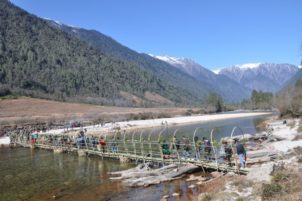
By Brototi Roy and Nick Meynen.
The lockdown from one pandemic is being used in India to pave the way for the next, with a controversial plan to clear extremely valuable forests.
The Dibang valley is very remote, even for the standards of India’s most Northeastern state. These tropical mountains are brimming with life: from birds to clouded leopards to indigenous communities.
The threat posed by two dams was enough to make #StopEtalinSaveDibang a nationally trending hashtag on twitter.
Dibang valley is both the largest district of Arunachal Pradesh and the least populated of the country. It features a vast variety of flora and fauna including that of six globally threatened mammals and four critically endangered birds.
Clearance
It is the home of the indigenous community of Idu Mishmi. They live with the area’s tigers in line with their cultural beliefs and traditions.
In 2008, the massive 3,097 MW Etalin hydroelectric project became one of three proposed projects in a joint venture between the Hydropower Development Corporation of Arunachal Pradesh Ltd and Jindal Power Limited.
For $3.3 billion these companies would build two run-of-the-river schemes, involving construction of dams on the Talo (often misspelt as Tangon in official documents) and Dri rivers, two tributaries of the Dibang river.
The Etalin project would involve chopping at least 280,000 trees of subtropical evergreen broad-leaved forest and subtropical rain forests in an area of more than 1,160 hectares.
In January 2017, the Ministry for Environment, Forests and Climate Change (MoEFCC) Expert Appraisal Committee for River, Valley and Hydroelectric Power Projects recommended the environmental clearance of the project.
Biodiversity
However, the Forest Advisory Committee the following month “recommended conducting multiple seasonal replicate studies on biodiversity assessment by an internationally credible institute”. This never happened.
The countrywide lockdown is now being enforced due to novel coronavirus crisis.
The Forest Advisory Committee (FAC) debated granting forest clearance to the project on 23 April 2020, resulting in many scientists and experts writing to the MoEFCC to warn about the consequences of this project.
Aside from the biodiversity and indigenous peoples, there is also the risk of creating a mega-dam in a region that has high seismic activity and 350 glacial lakes upstream that can create flood waves towards the structure.
This conflict is also linked to very differing views on the traditional ways of the conservation of biodiversity.
Indigenous
In 2018, the Idu Mishmi Cultural and Literary Society had written to the Director of National Tiger Conservation Authority to suggest a new “cultural model” of conservation that takes into account “a culture so far proven to be effective in saving the tigers”.
This clash between conservationist organisations who marginalise indigenous communities for political reasons and traditional ways of protecting biodiversity has been a hot topic in India for years, as some of our team have written about this earlier.
Doctor Sahil Nijhawan during his PhD at University College London studied the role of cultural norms in tiger conservation, using the Idu Mishmi as his case study.
He reminds us of the harsh local realities: “Well-equipped hospitals are far away over unreliable roads. Many people die on their way to healthcare. The State has failed to provide such basic facilities and has instead offered large hydropower projects.”
Nijhawan sees better ways of enhancing human wellbeing than relying on “failed and outdated models of ‘development’ at a time when the world is facing devastating impacts of climate change, pandemics linked to ecosystem destruction, and dispossession of local and indigenous cultures.”
Sampling
In this conflict there are also “Project Affected” families who support the project in the name of development, stating that the project will allow the state to be ‘economically self-reliant, independent and vibrant at parity with other developing states of northeastern region’.
Members of the Idu Mishmi community who are against the project claim that this is because some members of the community have been offered large amounts of money as compensation.
On May 4, 2020, 26 scientists from 15 institutions released peer reviewed research about the Wildlife Institue of India´s Etalin Wildlife Conservation Plan.
They point to a gap in the mandate for the study and say that despite clear directives to conduct a multi-seasonal study, Wildlife Institue of India only spent four months in the field.
They only surveyed a limited number of sites using biased sampling methods. As a result, their report hugely under-assesses the biodiversity of the region.
Pandemic
By suggesting mitigation measures, the report authors also presume the project to be cleared and presents it as a fait accompli. This implies that the report’s finding has no bearing on the FAC’s decision on the project, ultimately making it an exercise in futility.
In the last few weeks there have been a lot of online mobilizations: letters written to the government, peer reviews of the troubled study, twitter storms etc.
On May 9, 2020, ‘netizens’ participated in a nationwide tweet-storm demanding that Etalin hydropower project should be stopped, with the hashtags #StopEtalinSaveDibang and #SaveArunachalBiodiversity.
On May 11, 2020, the minutes of the meeting of 23 April were made available, according to which forest clearance wasn’t given yet. It rather sought inputs from the ministry of power on the feasibility of the project as well as a detailed cost-benefit ratio analysis.
It is too soon to tell whether the project will be granted forest clearance despite all the mobilization, the nation-wide twitter storm and a still deepening pandemic illustrating how connected the health of our natural world and the health of all people are.

The project ENVJUSTICE has received funding from the European Research Council (ERC) under the European Union’s Horizon 2020 research and innovation programme (grant agreement No. 695446)